 This set of Stations of the Cross was commissioned by the Aboriginal Catholic Ministry of Victoria in 2017 and are arranged along the main wall of their chapel in Thornbury, Melbourne. They were imagined, dreamed and painted by John Dunn, an Olkola/Djabaguy man from Far North Queensland.
This set of Stations of the Cross was commissioned by the Aboriginal Catholic Ministry of Victoria in 2017 and are arranged along the main wall of their chapel in Thornbury, Melbourne. They were imagined, dreamed and painted by John Dunn, an Olkola/Djabaguy man from Far North Queensland.
Along the seven-metre length, four journey tracks interweave: two undulating aboriginal tracks which integrate the aboriginal story with Christ’s own Way of the Cross and, along the top and bottom, tracks made of thorny branches which speak of colonisation and its impact on the Aboriginal community. The Passion of Christ resonates deeply with Aboriginal people who identify readily with his innocent suffering.
Artist John Dunn himself was caught up in the pain of the stolen generation. He did not find his family until he was in his 40s, after many years of searching. The process of painting this story was for him a personal discovery of his Aboriginality and his own hurt and isolation; the journey led him to peace and a healing of his spirit. All Aboriginal people recognise themselves in his struggle and in his emergence at the end, strengthened by a new hope. John wrote: Now all the name-calling I had endured seemed to make sense – bastard, half-cast, the list goes on. The constant abuse from my peers on many occasions ended eventually in my retaliating with force. I couldn’t wait to get out of there. One day, I often reminded myself, you’ll be free from all the name calling. I felt I had always been judged and sentenced as I was different from everyone else.

In these Stations, all Catholics will be able to read the story and recognise the grouping of the figures. But the paintings are rich with Aboriginal symbolism. Many of these recurring elements are visible even in the first Station.
 Aboriginal figures often watch from a distance in curiosity; sometimes they run to get away from what is happening.
Aboriginal figures often watch from a distance in curiosity; sometimes they run to get away from what is happening.

 Different animals are incorporated; they were vital for survival and used as totems for identification, like a birth, death and marriage directory. Each person is given a totem at birth that integrates them into their mother’s and father’s family. You cannot marry someone with the same totem; you must always protect your totem; you cannot harm, eat or hurt your totem.
Different animals are incorporated; they were vital for survival and used as totems for identification, like a birth, death and marriage directory. Each person is given a totem at birth that integrates them into their mother’s and father’s family. You cannot marry someone with the same totem; you must always protect your totem; you cannot harm, eat or hurt your totem.
 The tiny hand prints represent the ancestors in the Dreaming (heaven) watching over us for eternity; people must always respect their ancestors and never forget them for without them no one would be here today.
The tiny hand prints represent the ancestors in the Dreaming (heaven) watching over us for eternity; people must always respect their ancestors and never forget them for without them no one would be here today.
 John Dunn’s family from Far North Queensland are represented by the ceremonial head dresses still worn for special ceremonies and rituals; they are a recognition of Our Own People.
John Dunn’s family from Far North Queensland are represented by the ceremonial head dresses still worn for special ceremonies and rituals; they are a recognition of Our Own People.
 The circles in the Aboriginal journey tracks represent Aboriginal people from different tribes meeting together; these meetings occur regularly in their journeys over this wide land.
The circles in the Aboriginal journey tracks represent Aboriginal people from different tribes meeting together; these meetings occur regularly in their journeys over this wide land.
 The colours reflect the Australian continent and the ochres traditionally used for artwork and for body paint in ceremonies and rituals; Aboriginal spirituality recognises that human lives are governed by the Creator Spirit.
The colours reflect the Australian continent and the ochres traditionally used for artwork and for body paint in ceremonies and rituals; Aboriginal spirituality recognises that human lives are governed by the Creator Spirit.
 Most powerfully of all, the figure of Jesus is draped in a Possum Skin Cloak. These were very important especially for the colder parts of the country where they were used as baby blankets and clothing to keep people warm. When a baby is born, the parents stitch possum skins together (the mother’s family tree shown on one side and the father’s on the other). As the child grew, they would add more possum skins to keep the child warm. By the time the person was an adult, the skin would contain their whole life story. Originally people would be buried in these skins, so they would die wrapped in family and culture. The possum skin that Jesus wears has thatched markings taken from Tiwi art to cover and protect him.
Most powerfully of all, the figure of Jesus is draped in a Possum Skin Cloak. These were very important especially for the colder parts of the country where they were used as baby blankets and clothing to keep people warm. When a baby is born, the parents stitch possum skins together (the mother’s family tree shown on one side and the father’s on the other). As the child grew, they would add more possum skins to keep the child warm. By the time the person was an adult, the skin would contain their whole life story. Originally people would be buried in these skins, so they would die wrapped in family and culture. The possum skin that Jesus wears has thatched markings taken from Tiwi art to cover and protect him.
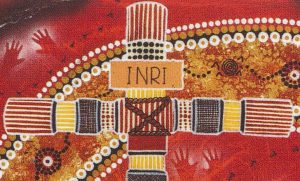 The cross which Jesus carries also uses Tiwi designs; it demonstrates the Jesus’ story is inclusive of the many different tribes and arts from all parts of Australia.
The cross which Jesus carries also uses Tiwi designs; it demonstrates the Jesus’ story is inclusive of the many different tribes and arts from all parts of Australia.
These artworks are unique, very vibrant and engaging, not only raw and heart-felt for John Dunn, but capturing at a deep level the experience of all Aboriginal people. They encourage reflection on the story of Aboriginal Australia, an awareness of discrimination and the disregard for human rights, and a yearning for healing and justice. They are an invitation to the wider community to connect with the faith and spirituality of Aboriginal people who have carried the Creator Spirit with them since time immemorial.
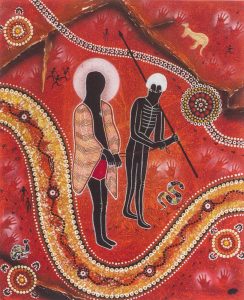
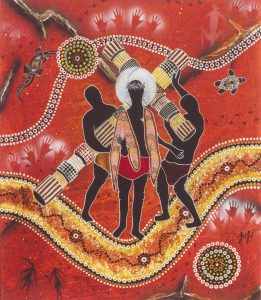
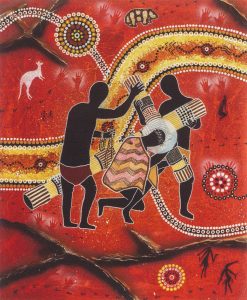

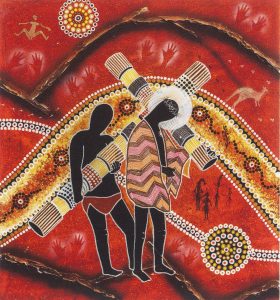
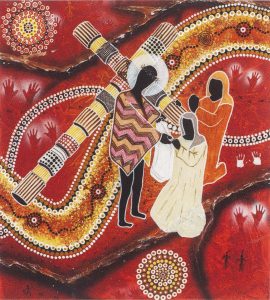
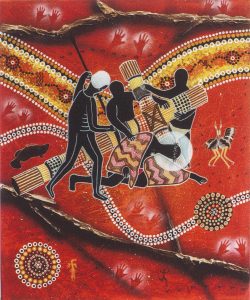
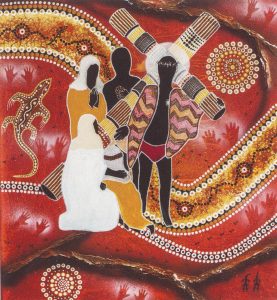
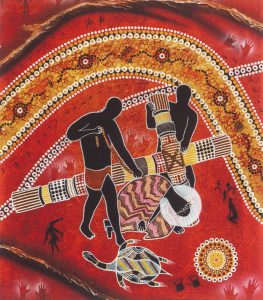
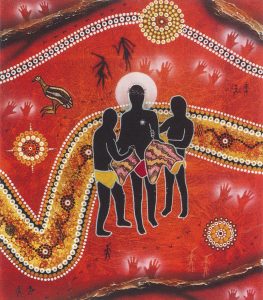



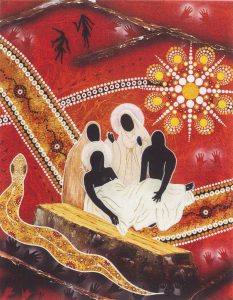
Aboriginal Catholic Ministry, Victoria, has produced this set of Stations of the Cross as a set of Prayer Cards which is available for sale at $15.00 a set.
